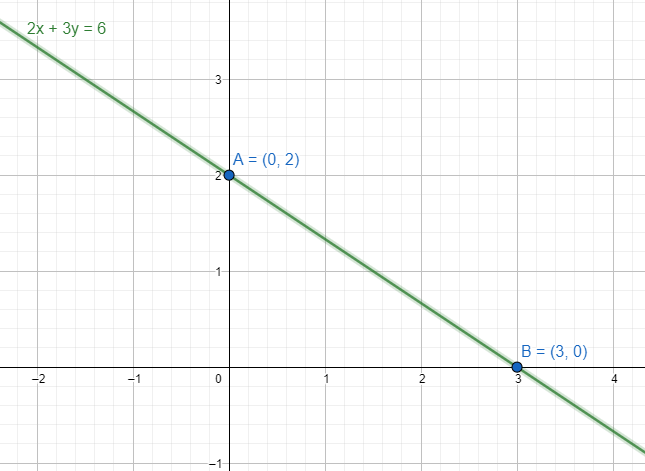
How do you write the equation of the line that passes through the point $\left( 6,-2 \right)$ and has a slope of $-\dfrac{2}{3}$?
Answer
526.5k+ views
Hint: We first take the general equation of a line where we have the slope and intercept form as $y=mx+c$. We put the given values of slope $m=-\dfrac{2}{3}$ and the point $\left( 6,-2 \right)$. Then we place the equation in the graph to visualise its intercept form.
Complete step-by-step answer:
We take the general equation of the line with the slope $m$ as $y=mx+c$.
It’s given that the value of the slope for our required line is $m=-\dfrac{2}{3}$.
Putting the value in the equation of $y=mx+c$, we get $y=-\dfrac{2}{3}x+c$.
As the line passes through $\left( 6,-2 \right)$.
Putting the value in the equation $y=-\dfrac{2}{3}x+c$, we get $-2=\left( -\dfrac{2}{3} \right)\times 6+c$.
We simplify the equation.
$\begin{align}
& -2=\left( -\dfrac{2}{3} \right)\times 6+c \\
& \Rightarrow c=4-2=2 \\
\end{align}$
This gives $c=2$.
The equation of the line becomes $y=-\dfrac{2}{3}x+2$.
To simplify the equation, we multiply both sides with 3 and get
$\begin{align}
& 3y=3\left( -\dfrac{2}{3}x+2 \right) \\
& \Rightarrow 3y=-2x+6 \\
& \Rightarrow 2x+3y=6 \\
\end{align}$
The final equation of the line becomes $2x+3y=6$.

Note: For this equation $2x+3y=6$ we can convert it into the form of $\dfrac{x}{p}+\dfrac{y}{q}=1$. From the form we get that the x intercept, and y intercept of the line will be p and q respectively.
The given equation is $2x+3y=6$. Converting into the form of $\dfrac{x}{p}+\dfrac{y}{q}=1$, we get
$\begin{align}
& 2x+3y=6 \\
& \Rightarrow \dfrac{2x}{6}+\dfrac{3y}{6}=1 \\
& \Rightarrow \dfrac{x}{3}+\dfrac{y}{2}=1 \\
\end{align}$
The intersecting points for the line $2x+3y=6$ with the axes will be $\left( 3,0 \right)$ and $\left( 0,2 \right)$.
Complete step-by-step answer:
We take the general equation of the line with the slope $m$ as $y=mx+c$.
It’s given that the value of the slope for our required line is $m=-\dfrac{2}{3}$.
Putting the value in the equation of $y=mx+c$, we get $y=-\dfrac{2}{3}x+c$.
As the line passes through $\left( 6,-2 \right)$.
Putting the value in the equation $y=-\dfrac{2}{3}x+c$, we get $-2=\left( -\dfrac{2}{3} \right)\times 6+c$.
We simplify the equation.
$\begin{align}
& -2=\left( -\dfrac{2}{3} \right)\times 6+c \\
& \Rightarrow c=4-2=2 \\
\end{align}$
This gives $c=2$.
The equation of the line becomes $y=-\dfrac{2}{3}x+2$.
To simplify the equation, we multiply both sides with 3 and get
$\begin{align}
& 3y=3\left( -\dfrac{2}{3}x+2 \right) \\
& \Rightarrow 3y=-2x+6 \\
& \Rightarrow 2x+3y=6 \\
\end{align}$
The final equation of the line becomes $2x+3y=6$.

Note: For this equation $2x+3y=6$ we can convert it into the form of $\dfrac{x}{p}+\dfrac{y}{q}=1$. From the form we get that the x intercept, and y intercept of the line will be p and q respectively.
The given equation is $2x+3y=6$. Converting into the form of $\dfrac{x}{p}+\dfrac{y}{q}=1$, we get
$\begin{align}
& 2x+3y=6 \\
& \Rightarrow \dfrac{2x}{6}+\dfrac{3y}{6}=1 \\
& \Rightarrow \dfrac{x}{3}+\dfrac{y}{2}=1 \\
\end{align}$
The intersecting points for the line $2x+3y=6$ with the axes will be $\left( 3,0 \right)$ and $\left( 0,2 \right)$.
Recently Updated Pages
Master Class 8 Maths: Engaging Questions & Answers for Success

Class 8 Question and Answer - Your Ultimate Solutions Guide

Master Class 7 Maths: Engaging Questions & Answers for Success

Class 7 Question and Answer - Your Ultimate Solutions Guide

Master Class 6 Maths: Engaging Questions & Answers for Success

Class 6 Question and Answer - Your Ultimate Solutions Guide

Trending doubts
What is meant by exothermic and endothermic reactions class 11 chemistry CBSE

Which animal has three hearts class 11 biology CBSE

10 examples of friction in our daily life

One Metric ton is equal to kg A 10000 B 1000 C 100 class 11 physics CBSE

1 Quintal is equal to a 110 kg b 10 kg c 100kg d 1000 class 11 physics CBSE

Difference Between Prokaryotic Cells and Eukaryotic Cells




